What a stupid card game.
You’re dealt some numbers between one and six, and possibly one or more bright absurdist rainbow llamas. You want to get rid of these silly digits because any you’re left with at the end of the round are points. L.L.A.M.A, like golf, is a dignified pastime. It’s also scored in reverse, with points being the bane of your pack animal existence. Or maybe you’re not the llama in this delusion. I don’t know what you are. I barely know what this game is.
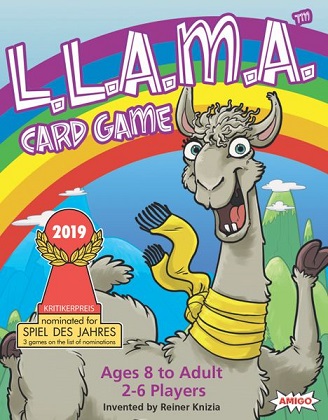
How do you get rid of those cards? Besides chewing them up as an ode to immersion, you can play them. On top of a stack. Like UNO.
But unlike that godawful game that my child won’t quit fishing out of the recycling bin, L.L.A.M.A. doesn’t care about colors. Instead, on your turn you can play atop the stack with a number that matches or is one higher. So, if a three is the current card, you can play a three or a four.
Simple stuff. A llama could almost play it. The rules are a single foldout page, so what were you expecting from this Spiel des Jahres nominee?
Don’t forget about those llama cards. They’re functionally sevens. You play them on top of a six or on top of another llama of course. At that point players can loop all the way around, playing a one when a llama is visible. Thus, the circle of life.
Rather than a number, they are sparkly uplifting llamas to remind you that they’re worth not seven, but 10 points if you keep them. Yep, it feels like the beaming goat-thing is kicking you in the side of the head with a crooked hoof.
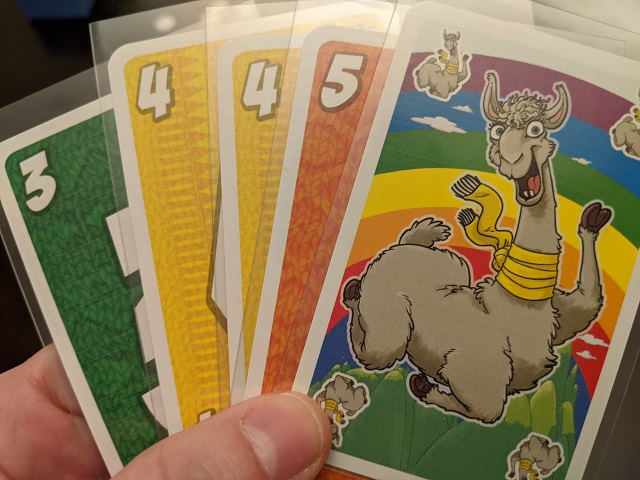
This is a divisive game. A large cohort believes it’s utterly random and devoid of decision space. Some are even angry that this was nominated for the Spiel.
Let’s steelman this argument.
There is really only one decision in this game. Now, that’s not an outright indictment as No Thanks! functionally has one decision, and that game is a banger. But the decision in L.L.A.M.A. is anchored to your draw and completely outside your control. Some players will objectively receive a better hand – such as one built exclusively of lower value numbers – or luck into their opponents playing cards that synergize with their options. It’s the fickle nature of the game and it’s laid bare due to the lack of mechanisms concealing the simplicity.
One decision, with three possible vectors. You can play a card, draw a card, or you can fold and bow out of the round.
Often you can’t even play a card. Professor Luck holds sway over your diminished options, and it’s difficult not to recognize that you will often be stuck with a chunk of points. It may have even been the best you could possibly do. Llama-ing ain’t fair.
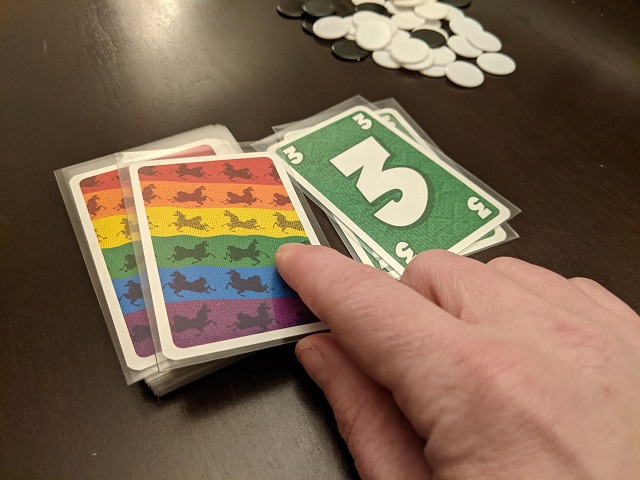
That all sounds reasonable.
But you’re forgetting something. This is a Reiner Knizia game.
Dr. Knizia’s designs are subtle. They reveal themselves over multiple plays. They are rarely obvious.
The problem with L.L.A.M.A. is that it feels so random and so ineffectual that unearthing the juicy llama meat is perhaps a bridge too far for many. It requires you keep an open mind and that you purposely look for those nuances. It’s easy to dismiss the game as not warranting that level of attention.
That’s fine. You can go play those games with real decisions. I’m sticking with L.L.A.M.A.
This is a brilliant and recurrently misunderstood design.
The subtlety occurs once you settle in. I’ve played hundreds of hands of this senseless game. I can tell you it’s not senseless.
L.L.A.M.A. is primarily a push your luck experience. Every single element of this game is focused through that decision to bow out of the round. This is because it is played across multiple hands, not stopping until someone reaches 40 points. Cutting bait and taking five points is much smarter than drawing another card and picking up a llama you can’t toss.
It’s a tricky thing. There’s a legitimate sense of pressure. I feel it in my gut.
The main source of this energy is due to the round ending early. If someone can play the last card in their hand, everything stops. You’re stuck, like a llama in mud. Maybe you’re holding a bunch of cards and just gained 12 points. Woof. Or naaaayyyy. Whatever sound a llama makes.
And you want to play that last card. Not just to stick it to the man, but also because it allows you to put a chip back into the pot, losing some of those nasty points you’ve been accruing.
This is the best part of the game so listen up.
When gaining points, you always turn in 10 white single point chips for a black 10 pointer. Essentially, you’re always turning change into dollars. This means that if you play your last card and complete the round, you get to return that 10-point chip to the pot.
Immediately, this has several implications.
First, it means you’re better off taking a couple of extra points to hit 10, instead of lingering at eight. Tossing a single white chip in and going down to seven points is much worse than coughing up a black chip and dropping to zero.
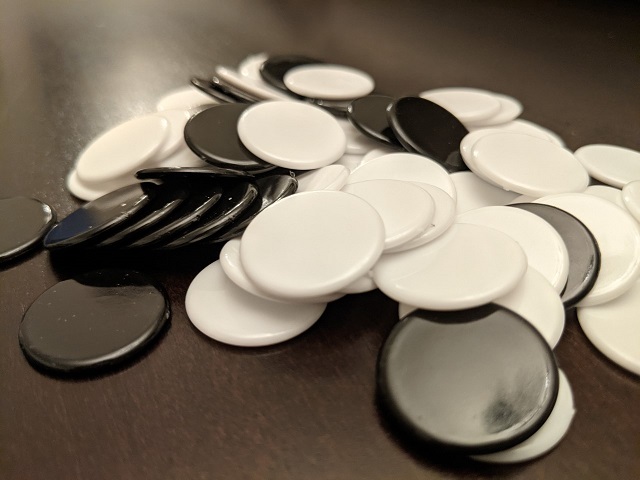
Damn it feels good to go out. Your friends groan and curl their lips. You smile and give ’em a wink.
This functions as impetus to play riskier, particularly when the end of the game draws near. Emptying your hand is always in sight.
As a mechanism, it also forces investment in your opponent’s position. If Jimmy is down to two cards, you may be better off just folding and taking five points as opposed to drawing in hopes of bettering your score.
You really must be aware of the table. In addition to remaining cards, you need to recognize each player’s point position.
Imagine this, Lilly is winning and has gone out of the round with two cards in hand. You could fold and add just a single point to your score. No, that’s wrong.
Rufus is holding four cards and he currently has 38 points. If you back out now, he will probably bust and the game will end with Lilly securing victory. You stay in.
Another little flourish: sometimes you draw even when it’s possible for you to play. Sometimes you keep drawing, filling your hand with an ugly number of cards. The FNGs at the table will be confused. They will think you’re tanking the game on purpose, gaining points for no good reason.
Then the final player will fold, leaving you alone. When left as the last active player, you can no longer draw cards. But you can play them. All of them.
You empty your whole hand and return a black chip to the middle. You sit back all chill and smug like you’re Samuel Llama Jackson.
And you try it again the next time you play. But this time Judy plays her last card before you can pull off your trick. High llama drama ensues, the world is upside down.
There’s also an interesting tempo, one which alternates within pockets of a single game, as well as across multiple plays. Certain groups will tend to rush the escalation of numbers, rarely playing the same option atop itself. Others will slowly draw out the process, hoping to avoid cycling through. With attentive care, you can feel this out.
That tempo shifts with the player count. With fewer participants it’s safer to slow play. You can expect by your next turn the current number will have moved far less than if five players have taken a turn in between yours. There’s a certain sense of intuition here that can be developed. You can take advantage of this peculiarity and improve at the game.
And if you’re really nutty, you can even count cards. There are eight copies of each number, so even with a smidge of effort you can recall that at least five or six threes were played in one particular series. If you draw a three, you know that others will likely stall out if the sequence loops back around. You can give the tempo a nudge to make or delay this from happening so that you can best time your series of moves.
L.L.A.M.A. certainly embraces luck, but it’s never consumed by it.
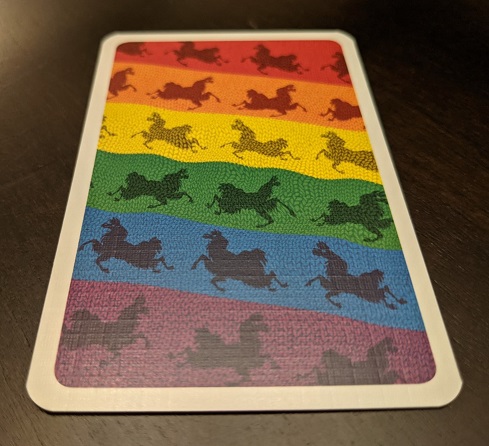
This game is bizarre and beautiful.
Some of you will say I’m overselling. Some of you will think I’ve got screws rattling around in my skull. You could be right.
It’s just a wonderful compact experience capable of delivering big releases.
Emotionally, it brushes up against poker. That push your luck element really elicits a similar feel, one which makes for unease and elation. You’re gambling, and if you don’t understand the subtleties, it’s like playing without knowing the odds.
Just One is a hell of a game, but it ain’t got nothing on L.L.A.M.A.
If you enjoy what I’m doing and want to support my efforts, please consider dropping off a tip at my Ko-Fi or supporting my Patreon.

“unearthing the juicy llama meat is perhaps a bridge too far”
GOLD
You had me in the first half, I’m not gonna lie… I should have known you would come around to the correct conclusion.
LikeLiked by 1 person
Yes, this game is an absolute gem.
LikeLike
You have nailed it on the brilliance of this game.
I will also add that, while the game is brilliant and definitely has some strategic depth, the rules set is simple enough that we’ve been able to play it with the elderly in our family (between 85 and 91).
LikeLiked by 1 person
Thanks, Roger. It is a rare game that can appeal to such a wide range of people.
LikeLike
My name is Matt and I am a PE teacher at an elementary school in Illinois. I just started a board game club at my school. I would love to expose my students and the school to fun, family friendly and educational games and puzzles. I am part of CUSD 300 in Illinois. It is one of the larger school districts in Illinois. I was writing to see if your company would consider donating any games to our school? I feel this could be an excellent way to advertise your games to the students and parents. I would love to have newsletters for the parents telling them all about your company and all the games that you donated. My plan is to send home a paper after each board game club session informing the parents which game the student played and who published and/or donated the games. I want to help direct my students and parents where they can learn more about the game and purchase a copy. I also plan to make myself available after school when the parents pick up their children so I can show them the games their kid played and give them a chance to ask questions and take pictures of the games. I’m also going to provide my email to the parents so they can ask me questions about all these things in case they did not have a chance to talk to me after each club session. I’m also going to ask the students and encourage the parents to let me know if they purchase any of the games. I would be happy to share that information with you as I thought it would be encouraging to know if students are enjoying your games and purchasing their own copies. I hope all these steps will encourage the parents to purchase some of these games to get them into the hobby. I am wanting to expose my students to the wonderful hobby of board and card games. I hope this club will play a small role in helping kids get off their phones and devices and stop playing video games. I would be grateful for one copy of a game or games or multiple copies. If I have multiple copies my plan would be to demo that particular game to all the students and then they can break off and all play the game at the same time which would be amazing! Thank you for your consideration and please let me know if you have any questions.
Sincerely, Matt Nelson
My school address:
Matt Nelson
Care of Algonquin Lakes Elementary School
1401 Compton Drive
Algonquin, IL 60102
LikeLiked by 1 person
Hey Matt,
I am not a company or publisher, but rather a hobbyist and sometimes journalist.
I’d recommend identifying specific games you’re interested in, and then contacting the companies that produce them.
LikeLike